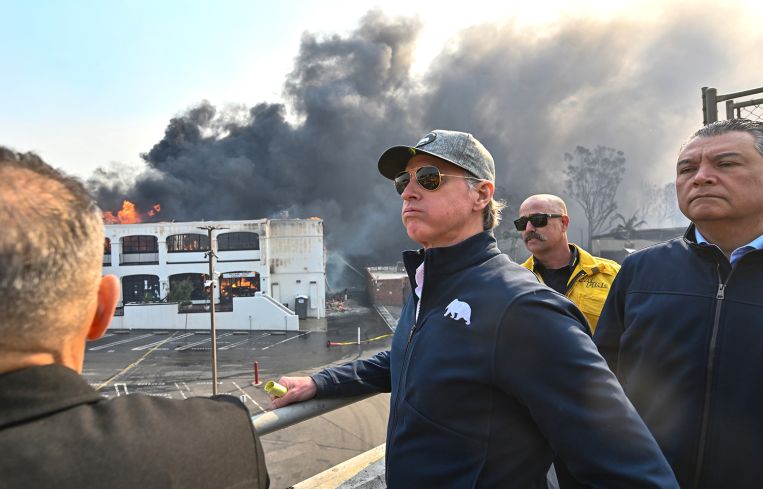UCLA: L.A. Fires Could Cost Up to $164B
If accurate, the figure would make the fires the second-costliest natural disaster in U.S. history, behind Hurricane Katrina
By Nick Trombola February 5, 2025 4:15 pm
reprints
Devastation incurred by the Palisades and Eaton fires in Los Angeles County last month could amount to the second-costliest natural disaster in U.S. history, according to a new analysis by UCLA.
Economists William Yu and Zhiyun Li, the authors of the report, estimate that total property and capital losses could range between $95 billion to as much as $164 billion, with insured losses alone accounting for an estimated $75 billion. The fires could also reduce economic activity in L.A. County by about $4.6 billion and lead to wage losses of nearly $300 million for local businesses and employees affected by the fires. Bloomberg first reported the news.
As of Wednesday, the blazes had killed 29 people and destroyed at least 16,244 structures, most of them single-family homes, according to the California Department of Forestry and Fire Protection. More than 430 fire-damaged buildings were commercial properties, including at least 234 multifamily sites.
Even the lowest cost estimate found in UCLA’s report dwarfs the economic toll of 2018’s Camp Fire, at the time the costliest blaze in California’s history, which racked up an estimated $30 billion in damage in the northern part of the state. If UCLA’s highest estimate proves accurate, the fires would only come in second nationally only to Hurricane Katrina, which cost an estimated $201 billion in adjusted cost after devastating New Orleans and its surrounding area in 2004, according to the National Oceanic and Atmospheric Administration. The L.A. fires in that case would also beat out 2017’s Hurricane Harvey, which cost an estimated $160 billion in adjusted costs.
Important to note, the report said, is that cost estimates for natural disasters, particularly for wildfires due to their volatile nature and variability of factors like population density and housing prices, range widely. Property data and analytics firm CoreLogic estimated in mid-January that the fires could cost between $35 and $45 billion in insurance losses, while Accuweather estimated over $250 billion in total damage and economic costs. Yu told Commercial Observer that estimates vary because there is no universal definition of costs associated with natural disasters — some estimates could include costs associated with long-term health consequences of the blazes, for example, he said.
Insurance assessments and payouts in particular are still in limbo at the moment as costs are being tallied.
Yu and Li note their estimate of $75 billion in insured losses does not represent the full cost to property owners. Many property owners affected by the fires were underinsured, or lacked coverage entirely. Some insurance companies, most notably the state’s biggest coverage provider in State Farm, canceled hundreds of policies in the Pacific Palisades just months before the fires began in early January. A more precise figure for insurance costs will likely become available within the next few months as insurers report their losses to the California Department of Insurance, Yu said.
Other L.A. County property owners still only had insurance coverage under California’s Fair Access to Insurance Requirements (FAIR) plan, which caps repayments at $3 million for residential properties and $20 million for commercial properties. That’s a significant amount of money, but still far less than the estimated value of many homes and buildings in the areas affected by the blazes.
The weighted median home price in the burned areas was nearly $2.1 million, according to UCLA’s report. Complicating matters, the FAIR plan had only $377 million available as of the week the fires began to pay claims, according to the New York Times.
Insurance rates are likely to significantly increase as companies seek to offset costs, the report notes. Indeed, State Farm this week sent a letter to the state’s Department of Insurance asking for an emergency rate hike of 38 percent for rental dwellings, 22 percent for non-tenant homeowners and 15 percent for condo owners, citing a “dire” financial situation in the wake of the fires.
The blazes could ultimately have severe consequences for public health as well. The fires released significant amounts of carbon, air pollutants and other toxins, the report said, citing data from the Copernicus Atmospheric Monitoring Service. January data showed total fire radiative power levels — which indicates fire intensity — far surpassing average levels seen between 2003 and 2024.
That air pollution could lead ultimately to a higher, if indirect, death toll. Fine particulate matter inhaled from wildfire smoke contributed to an estimated 52,480 to 55,710 deaths in California from 2008 to 2018, preceding an economic cost of between $432 to $456 billion, according to a 2024 study published in the journal Science Advances.
To decrease risk of future wildfire devastation, Yu and Li recommend comprehensive mitigation investment from the state, including adoption of advanced firefighting technologies and techniques. These technologies include using drones and AI for early detection, managing dense underbrush, reinforcing and rethinking building codes in high-risk areas and upgrading utility and civic infrastructure.
“Without significant and effective wildfire mitigation actions and investments, all California residents will face continued increases in insurance premiums and growing health concerns,” the report said. “We suggest that all adaptation and mitigation investments will be justified, considering the astronomical costs associated with wildfires.”
Nick Trombola can be reached at ntrombola@commercialobserver.com.


